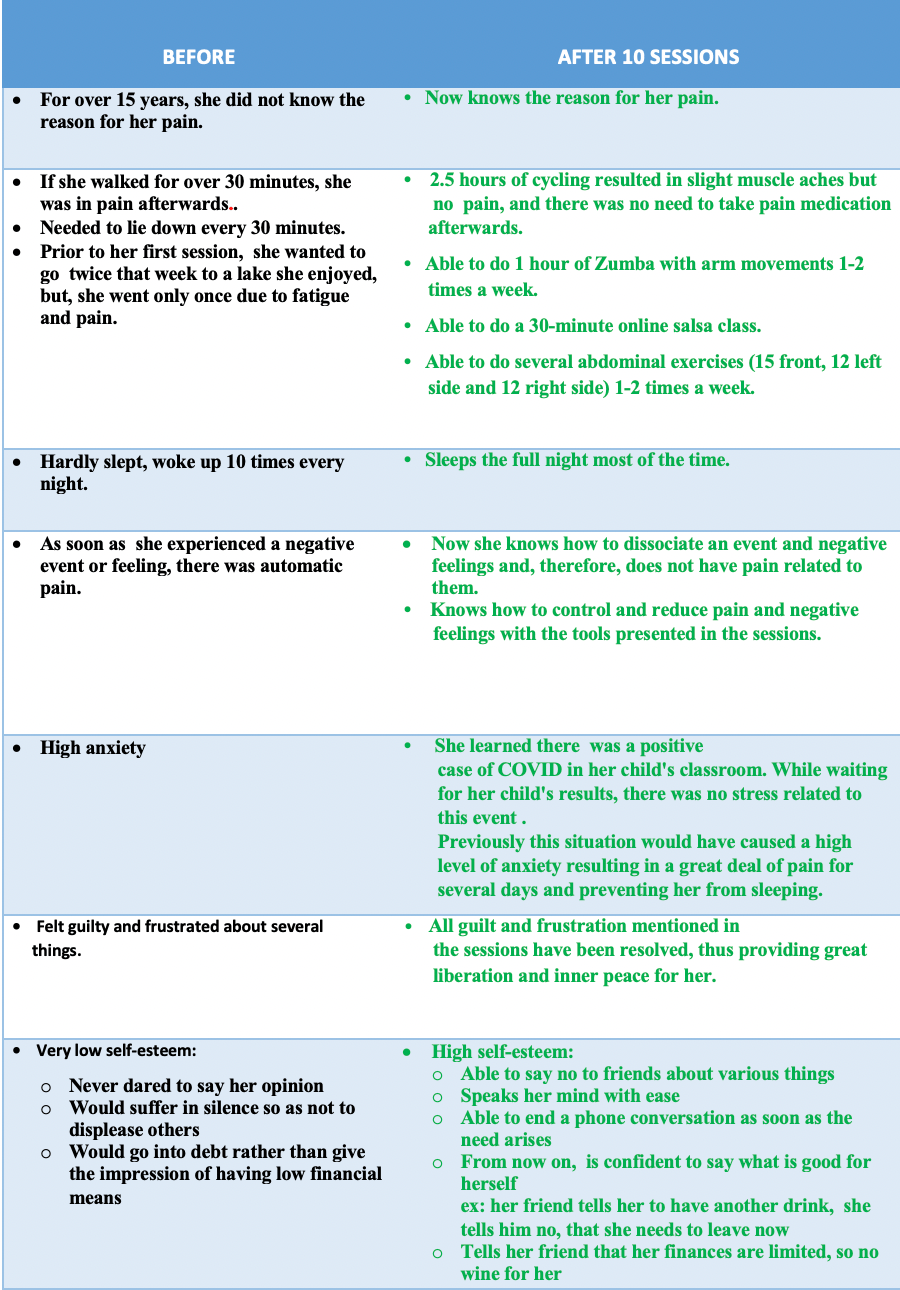Hypnosis to reduce chronic pain and a real case study
If we were to ask people to define pain, we would probably get as many answers as there are people. According to the International Association for the Study of Pain (IASP), pain is defined as “an unpleasant sensory and emotional experience associated with actual or potential tissue damage or described in these terms”.
An excellent tool to reduce pain and provide a better quality of life is hypnosis. The brain knows how to stop pain in the body and mind. Hypnosis will teach your brain how to turn off pain responses and thus relieve the sensations that result from the trauma (physical or emotional).
According to neuroscience studies conducted by Pierre Rainville of the Université de Montréal and researchers at the University Teaching Hospital (CHU) of Liège 1, the effects of hypnosis on pain can be explained by changes occurring in the brain of hypnotized people. Using technology that allows us to see what is happening in a patient’s brain, such as positron emission tomography and functional brain imaging, certain sections of the brain are activated, increasing the analgesic and anxiolytic effects produced by the body.The use of hypnosis in the operating room is widely accepted in Europe. Hypnosis is taught in some universities to psychologists, dentists, anesthesiologists and nurses. In Quebec, hypnosis is less used in the medical field than in France. However, the Association des Anesthésiologistes du Québec is beginning to take an interest in hypnosis since some of its members use it in palliative care.
Hypnosis to reduce pain: Science-based
Science has extensively studied the effect of hypnosis, especially in pain management. Out of a total of 10 studies, 6 used control groups on the use of hypnosis in patients suffering from chronic pain.
The first study 2 evaluated the hypnosis effect in 45 patients with idiopathic persistent orofacial pain. The patients were randomly divided into two groups, a group using hypnosis and a control group using relaxation suggestions only. In the hypnosis group, the results showed a significant decrease in pain intensity measured by the visual analog scale (VAS) compared to the second group.
A second study 3 with control groups, also involving 45 patients, but this time people suffering from fibromyalgia and with three control groups. The first group used hypnosis with analgesic suggestions, the second group used relaxation hypnosis and the third group used relaxation only. Even though all three groups showed a decrease in pain intensity (VAS), only the group with analgesic suggestions showed a marked effect in intensity and sensitivity. Interestingly, the group using relaxation hypnosis was not superior to the group using relaxation alone, which illustrates the effectiveness of hypnosis with analgesic suggestions.
In another study with a control group concerning fibromyalgia 4, the group that received hypnosis sessions saw a significant improvement in muscle pain relief while the control group saw a deterioration. At the end of the study, the people in the control group were treated with hypnosis and their conditions improved. One year later, the same result was seen in all participants who received hypnosis.
Here is a study with three groups 5: a hypnosis group, a Jacobson relaxation group and a control group of 36 patients suffering from gonarthrosis and/or coxarthrosis. A 56% decrease in pain was observed after four weeks in the hypnosis group, and 31% in the relaxation group after eight weeks. In both groups, the analgesic effect was maintained for six months. A decrease in the consumption of analgesics was also noticed in both groups.Two Meta-analysis (study of studies), where hypnotherapy has been proven to be effective in the treatment of chronic pain.
The first is a meta-analysis carried out in 2000, on articles published by psychologists, showed that 75% of participants, all with different types of pain, had a substantial reduction in pain using hypnotic techniques 6. A more recent meta-analysis conducted in 2014 revealed that hypnosis had a moderately superior effect when compared to other psychological interventions. The results suggest that hypnosis is efficacious in managing chronic pain 7.
Drs. Patterson and Jensen have found that hypnosis therapy is equivalent to or more efficient than other treatments for chronic pain 8.
Hypnosis is recognized as an effective therapy for managing pain and for relieving side effects of cancer treatment and stress-related disorders 9 10.
The patients who received hypnosis showed significantly better outcomes in measures of muscle pain, fatigue, sleep disturbance, distress, and the patients’ overall self-assessments compared with patients in the physical therapy group 11.
Two real cases study
Following the research presented, here are two real cases of two clients suffering from chronic pain. The first case is a person who has seen specialists for over 15 years without any improvement or finding the reason for her pain. Here is a table of concrete results after ten sessions. The second case is a person who has suffered from chronic pain for more than 8 years without having any relief.
The objective is not to highlight my competence, but rather to give hope to people who suffer from chronic pain, especially those who have seen several specialists but still don’t have answers. It is possible to improve your condition, regardless of how long you have suffered.

Here is the second real case.


Each case is a special case. I don’t pretend to have such amazing results as these for every client. This is to illustrate what the combination of hypnotherapy, other types of techniques, and my coaching experience can do. There is help for very serious cases, even when specialists have not been able to improve a person’s quality of life after 15 years or 8 years of treatment.
Is your pain the result of secondary gain?
Something we often see about chronic pain is the secondary gain. This can be a very real cause of pain. From the past, our minds learn that pain brings us benefit.
Even though, as adults, we can logically understand this and know what benefit we might derive from the pain, we are unable to move past it.
When you discover what the secondary gain is, then the pain often goes away.
Be it through studies or with the concrete example mentioned in this blog, hypnosis seems to be a very promising and safe tool to help people with chronic pain. Hypnosis is used to perform surgery without anesthesia allowing patients to be operated efficiently without feeling pain and having a much faster recovery. Dentists use hypnosis when a patient needs treatment and cannot tolerate anesthesia. So imagine what hypnosis can do to relieve your pain even if it is chronic.
References:
1- Rainville P, Duncan G H, Price D D, Carrier B, Bushnell M C, 1997, “Pain affect encoded in human anterior cingulate but not somatosensory cortex”, Science, Vol. 277, Issue 5328, pp. 968-971
2- Abrahamsen R, Baad-Hansen L, Svensson P. “Hypnosis in the management of persistant idiopathic orofacial pain” – Clinical and psychosocial findings. Pain 2008;136:44-52
3- Castel A, Pérez M, Sala J, et al. “Effect of hypnotic suggestion on fibromyalgic pain : Comparison between hypnosis and relaxation”. Eur J Pain 2007;11:463-8
4- Grondahl JR, Rosvold EO. 2008, “Hypnosis as a treatment of chronic widespread pain in general practice: a randomized controlled pilot trial”
5- Gay MC, Philippot P, Luminet O. 2002 “Differential effectiveness of psychological interventions for reducing osteoarthritis pain : A comparison of Erickson hypnosis and Jacobson relaxation.” Eur J Pain
6- Haanen HC, Hoenderdos HT et al. 1991 “ Controlled trial of hypnotherapy in the treatment of refractory fibromyalgia”. Jan; 18(1):72-5
7- MontGomery G, Duhamel KN, Reed WH, 2008. “A meta-analysis of hypnotically induced analgesia : How effective is hypnosis? ” International Journal of clinical and Experimental hypnosis. Mount Sinai School of medicine, New York, New York, P. 138-148
8- Elkins G, Jensen MP, and Patterson DR, 2007 “Hypnotherapy for the Management of Chronic Pain” International Journal of Clinical and Experimental Hypnosis
9- Jensen MP, Patterson DR. 2006 “Hypnotic treatment of chronic pain”. Journal of Behavioral Medicine. ;29:95–124
10- Vanhaudenhuyse A, Gillet A, Malaise N, et al. 2015 Efficacy and cost-effectiveness: A study of different treatment approaches in a tertiary pain centre. Eur J Pain. 19(10):1437–1446.
11- Park C. 2013 Mind-body CAM interventions: current status and considerations for integration into clinical health psychology. J Clin Psychol. ;69(1):45–63

Luis Lopes
I am a hypnotherapist certified by the National Guild of Hypnotists specialized in addiction relapse prevention and chronic pain. What always fascinated me is the ability for human beings to change, because changing and implementing permanent change is the most difficult thing for people to accomplish. My master thesis demonstrated that among the 5 obstacles for achieving objectives, the greatest was to take action. If you want to change something in your life and be happier, contact me to help you discover the permanent path to change.

